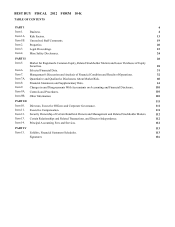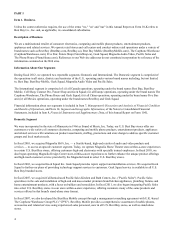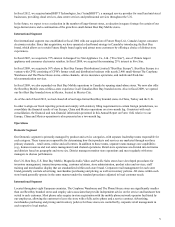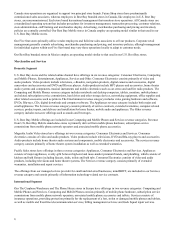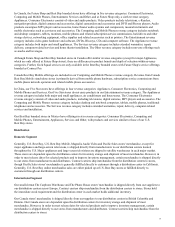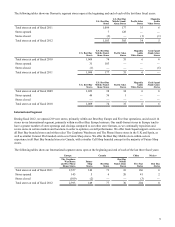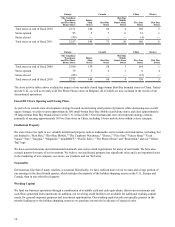Best Buy 2012 Annual Report Download - page 13
Download and view the complete annual report
Please find page 13 of the 2012 Best Buy annual report below. You can navigate through the pages in the report by either clicking on the pages listed below, or by using the keyword search tool below to find specific information within the annual report.13
Corporate Governance and Public Policy Committee. These documents are posted on our Web site at
www.investors.bestbuy.com — select the the "Corporate Governance" link.
Copies of any of the above-referenced documents will also be made available, free of charge, upon written request to:
Best Buy Co., Inc.
Investor Relations Department
7601 Penn Avenue South
Richfield, MN 55423-3645
Item 1A. Risk Factors.
Described below are certain risks that our management believes are applicable to our business and the industry in which we
operate. There may be additional risks that are not presently material or known. You should carefully consider each of the
following risks and all other information set forth in this Annual Report on Form 10-K.
If any of the events described below occur, our business, financial condition, results of operations, liquidity or access to sources
of financing could be materially adversely affected. The following risks could cause our actual results to differ materially from
our historical experience and from results predicted by forward-looking statements made by us or on our behalf related to
conditions or events that we anticipate may occur in the future. The following risks should not be construed as an exhaustive
list of all factors that could cause actual results to differ materially from those expressed in forward-looking statements made
by us or on our behalf. All forward-looking statements made by us or on our behalf are qualified by the risks described below.
If we do not anticipate and respond to changing consumer preferences in a timely manner, our operating results could
materially suffer.
Our business depends, in large part, on our ability to successfully introduce new products, services and technologies to
consumers, the frequency of such introductions, the level of consumer acceptance, and the related impact on the demand for
existing products, services and technologies. Consumers continue to have a wide variety of choices in terms of how and where
they purchase these products, services and technologies. Consumers also continue to benefit from the convergence of
technology products, where one product combines and replaces several others. Failure to accurately predict and adapt to
constantly changing consumer tastes, preferences, spending patterns and other lifestyle decisions, or to effectively address
consumer concerns, could have a material adverse effect on our revenue, results of operations and reputation with our
customers.
Economic conditions in the U.S. and key international markets or other conditions leading to a decline in consumer
discretionary spending may materially adversely impact our operating results.
We sell certain products and services that consumers may view as discretionary items rather than necessities. As a result, our
results of operations tend to be more sensitive to changes in macroeconomic conditions that impact consumer spending,
including discretionary spending. Other factors, including consumer confidence, employment levels, interest rates, tax rates,
consumer debt levels, consumers' ability to obtain credit, and fuel and energy costs could reduce consumer spending or change
consumer purchasing habits. In the past three fiscal years, many of these factors adversely affected consumer spending and,
consequently, our business and results of operations. A slowdown in the U.S. or global economy, continued economic and
financial instability in Europe, or an uncertain economic outlook, could materially adversely affect consumer spending habits
and our operating results in the future.
The domestic and international political situation also affects consumer confidence. The threat or outbreak of domestic or
international terrorism, civil unrest or other hostilities could lead to a decrease in consumer spending. Similarly, an overly anti-
business climate or sentiment could potentially lead consumers to decrease or shift their spending habits. Any of these events
and factors could cause a decrease in revenue or an increase in inventory markdowns or certain operating expenses, which
could materially adversely affect our results of operations.
Other conditions or factors that may impact our results of operations include disruptions to the availability of content such as
sporting events or other televised content. Such disruptions may influence the demand for hardware that our customers
purchase to access such content, as well as the commissions we receive from subscription services. Accordingly, such
disruptions could cause a material adverse effect on our revenue and results of operations.


